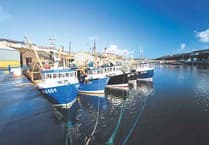Bude and District U3A have travelled more than 300-million years into the past thanks to a recent talk.
At the most recent meeting, the group welcomed visiting speaker for the afternoon, Matthew Thomas, whose talk was entitled “The Castle Heritage Centre, Bude”, who took listeners on a deep dive through Bude’s history.
Matthew works at the Castle as the outreach officer. He began by explaining that during medieval times, ‘hundreds’ were the main administrative subdivisions of a county, Cornwall had nine hundreds.
At the time of the Doomsday survey (1085-86), ‘Stratone’, was the largest and most important place in the hundred to which it gave its name. He then talked about the geology in this area, during the Carboniferous Period – 300-million years ago Britain was south of the equator. The Earth was in titanic upheaval with Africa crashing into Europe at the speed finger nails grow. The colossal pinching of these two land masses created a super lake stretching thousands of kilometres - east to west and hundreds of kilometres north to south.
Over time this salt water freshened and became known as Lake Bude. In the 1930s, the remains of a fossil fish were discovered in the unique Bude Rock Formation. The fossil was classified as a new species and named Cornuboniscus Budensis. Sardine-sized, and armed with razor sharp teeth like a Piranha. The Castle is the only place you can see this fossil.
Matthew continued to talk about the geology of the area, which is unique, called the “The Bude Formation” - Rock formations which are folded, buckled and twisted created when land masses collided during continental drift and inclined strata. During the Ice Age, around the area of Morwenstow, there are several deep sided valleys which formed during that period as ice melted and water and stone found its way to the sea. During the Holocene Period at the end of the Ice Age there were several Forests of Oak, Hazel and Elm was up to four miles further out than the current coastline. Sea levels rose again as the ice age ended and the ice melted and flooded these forests. Evidence of this was discovered when a part of a tree was found under the sand on Crooklets dates back to around 5,000 years ago. Matthew then talked about Medieval Bude and Stratton: Stratton was a market town In 1207 King John granted a charter for three fairs a year to be held in the town, an indication of Stratton’s status. In 1184, Stratton was divided into two manors, Binhamy and Efford. Bude was little more than a few fishing cottages and lime kilns.
Stratton Town has existed as a settlement from around 880AD, then in 1184 it was divided in two Manors: Ebbingford Manor which is the oldest inhabited house in Bude. First mentioned in 1183, Among the first tenants were the Heriz family, tenants of the Earl of Cornwall. St Leonards is possibly one of the oldest private chapels in the world.




.jpeg?width=209&height=140&crop=209:145,smart&quality=75)
Comments
This article has no comments yet. Be the first to leave a comment.